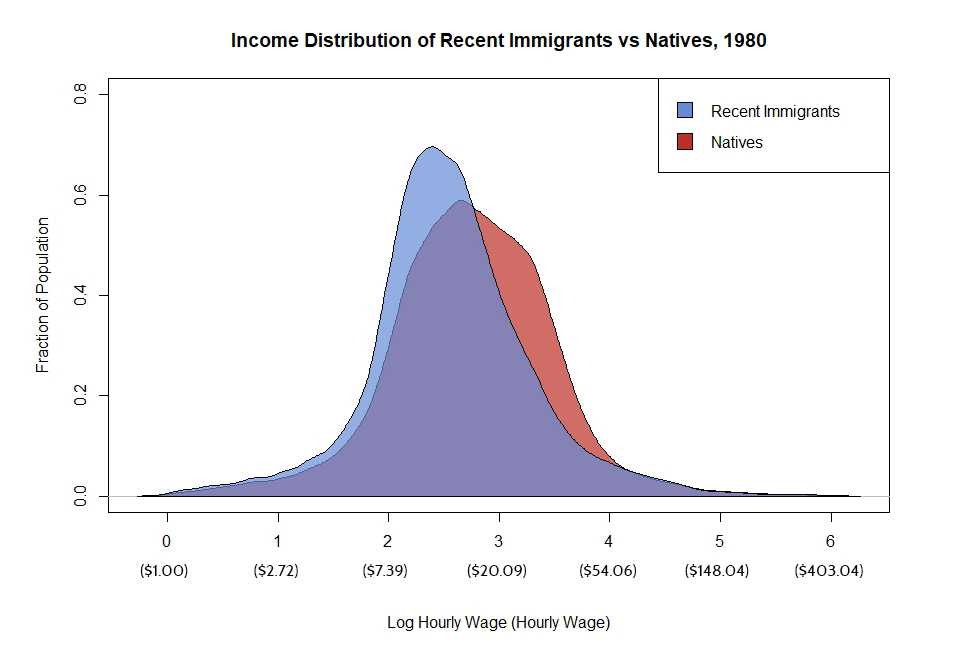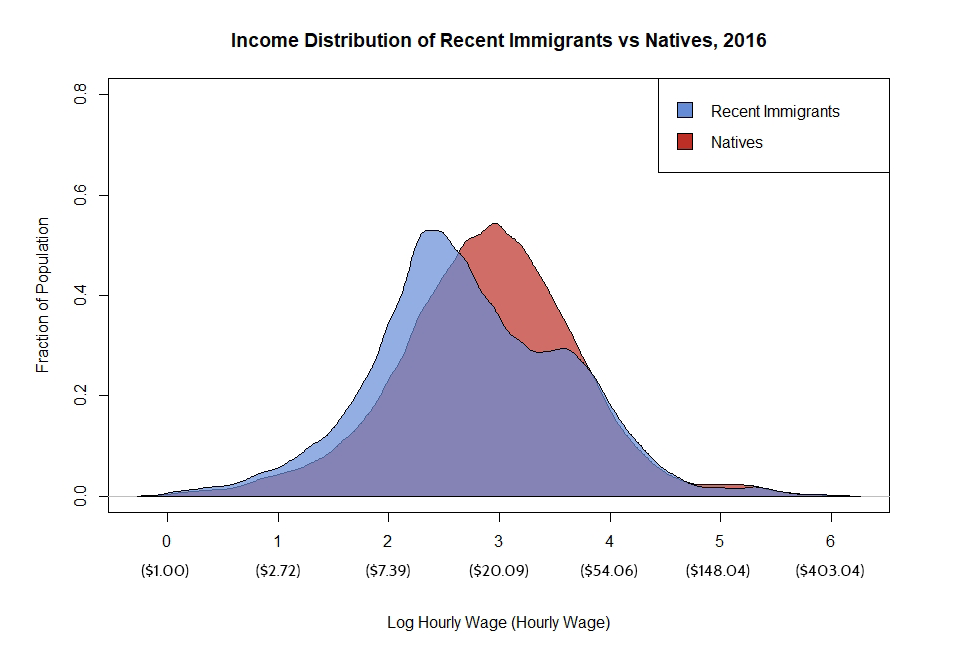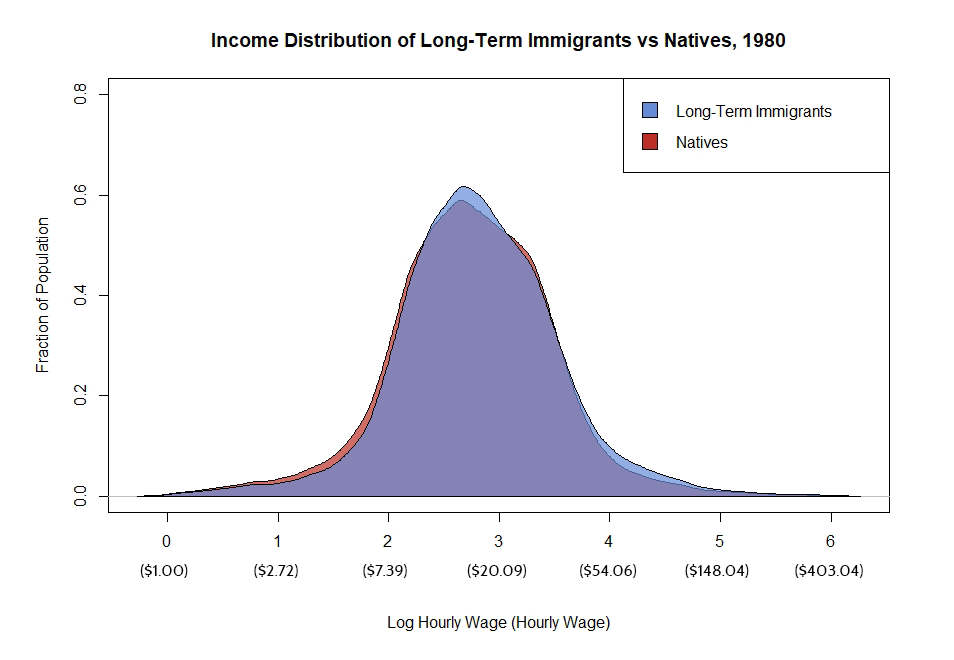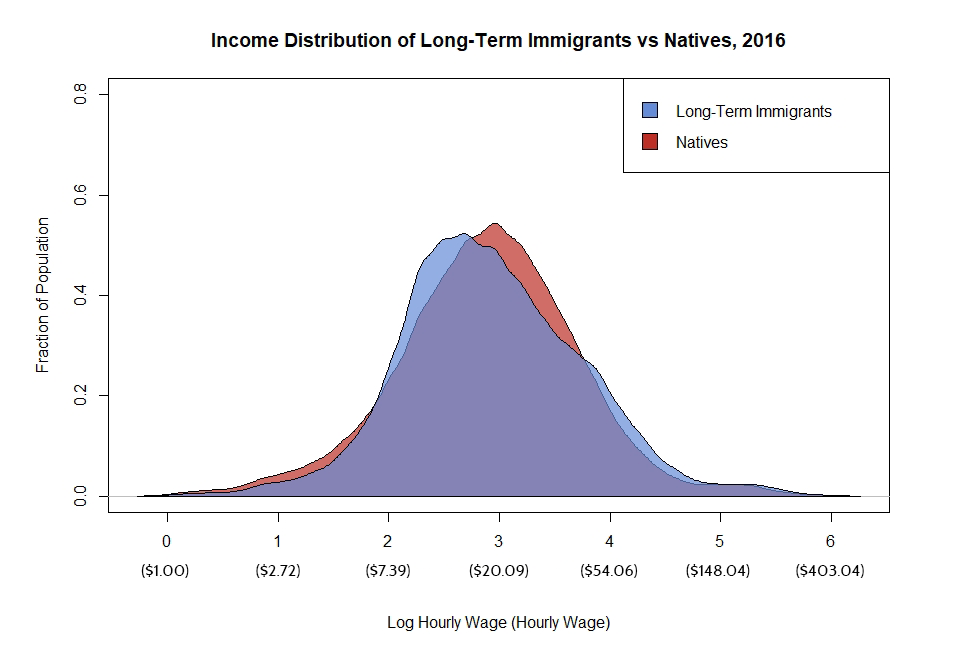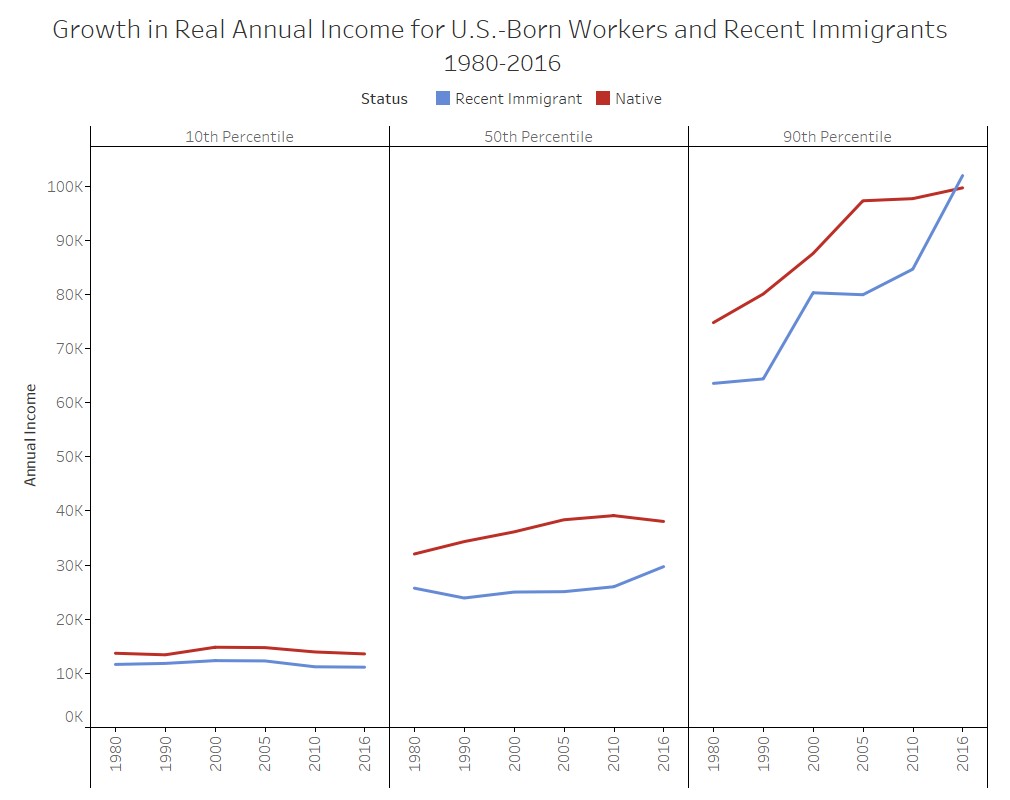Insight
October 11, 2018
Are Immigrants Driving Income Inequality?
Executive Summary
- Immigrants arriving to the United States today from every region of the world are more educated than in the past, leading to substantial wage gains over time; the income distribution of immigrants now closely mirrors the distribution for the native-born U.S. population.
- The earnings of the lowest-income native workers and immigrants have remained largely steady since 1980, even while the proportion of low-skilled immigrants has increased, suggesting that immigrants are not depressing wages. At the same time, immigrants at the top of the income distribution are earning far more now than in 1980 and even surpassing the earnings of U.S.-born workers.
- This analysis supports much of the academic literature, which indicates that immigration has, at most, a modest impact in either direction on the wages of U.S.-born workers. Research suggests that this impact has not significantly affected income inequality in the United States.
Introduction
President Trump has emphasized immigration reform as a key priority of his administration. One of the main pillars of this reform is reducing family-based immigration; he argues that this “chain migration” attracts low-skilled immigrants, who in turn increase labor-market competition and put downward pressure on native wages. He also argues that low-skilled immigration puts a higher burden on U.S. taxpayers by increasing the number of people receiving welfare benefits. Alternatively, others argue that immigration benefits the economy by increasing the size of the labor force, increasing demand for goods and services, and spurring economic activity. Furthermore, they argue that immigrant workers do not have a large impact on wages.
These alternative accounts of the impact of immigration raise the question: How do immigrants impact the wages of U.S.-born workers? Furthermore, it is evident that income inequality has increased in the past several decades, although there is considerable debate about how much. But how much of the increase in inequality is the result of immigration? Examining the shifting demographics of immigrants and how their income compares to native-born workers sheds light on the relationship between immigration and inequality in the United States.
Demographic Trends
To begin answering the questions outlined above, it is helpful to examine the demographics of immigrants coming to the United States. Foreign-born individuals today make up 14 percent of the total U.S. population, up from 5 percent in 1970 (but roughly equivalent to the immigrant share of the of population in the late 19th century). They are also increasingly more educated. According to Pew Research Center, the percent of new arrivals to the United States with at least a bachelor’s degree has been consistently rising, up from 20 percent in 1970 to 41 percent in 2015. This higher educational attainment is driven in part by the changing source countries of new immigrants. Today, Asia is the largest source of new immigrant arrivals, making up 41 percent of new arrivals compared to 19 percent in 1970. These immigrants are disproportionally more educated, with 57 percent holding at least a bachelor’s degree.
At the same time, the rise in immigration from Latin America has contributed to a greater number of immigrants with lower levels of educational attainment. In 2013, 28 percent of new arrivals came from Latin America. This is higher than in 1970 (20 percent) but significantly lower than in 2000 (48 percent), largely due to a slowdown in unauthorized immigration from Mexico. While the percentage of new arrivals from Latin America with at least a bachelor’s degree has increased (from 3 percent in 1980 to 13 percent in 2013 for Mexican immigrants, and from 17 percent to 28 percent for other Latin American immigrants), it is still disproportionately lower than the average new arrival.
These demographics help to explain why new immigrants are more likely to have both higher and lower levels of educational attainment than natives. Today, new immigrants are 11 percentage points more likely than native-born workers to have completed a bachelor’s degree, as well as 13 percentage points less likely to have completed high school. This disparity has increased since 1970, when new arrivals were 9 percentage points more likely to hold a bachelor’s degree and three percentage points more likely to have only completed high school.
While there is a growing gap in the education levels of new immigrant arrivals, lower educational attainment does not necessarily indicate lower economic contributions. The following analysis compares the wage distribution of immigrants and U.S.-born workers to determine how well immigrants are assimilating and what impact, if any, they might have on income inequality.
Economic Trends
There are two main ways that immigrants entering the labor market can impact native wages and income inequality. The first is purely by their inclusion in the wage distribution, where the impact depends on how immigrants fare themselves. If immigrants earn significantly lower wages than native workers, their inclusion should increase inequality. On the other hand, if immigrant wages are similar to native wages, income inequality should not be significantly impacted.
The second channel pertains to immigrants’ effects on the wages of the rest of the workforce. If immigrants undercut native workers and drive down wages for all workers at the bottom of the income distribution, then their inclusion should increase inequality relative to the baseline. By the same token, if immigrants fill legitimate labor market needs and have positive economic impacts by, for example, starting businesses, raising productivity, and stimulating innovation, then their inclusion should reduce inequality by raising wages for everyone.
The income distribution for U.S. workers, broken down between U.S.-born workers and recently arrived foreign-born workers (those arriving within the past five years), sheds light on how immigrant demographics impact the labor market. The following chart compares the distribution of real hourly wages for native and recent immigrant workers in the United States in 1980 and in 2016, the most recent year for which data are available.[i]
All data are taken from samples of the decennial censuses and the American Community Survey (ACS), which tracks the social and economic characteristics of the U.S. population. Wages are calculated by dividing annual salaries by reported number of hours and weeks worked, and all wages are in 2016 dollars (transformed using the consumer price index).
The above charts are probability distributions: the higher the curve at a given wage, the more likely it is for an individual surveyed to earn that wage. Because the distribution of wages is exponential – those at the top earn many times more than those at the bottom – the chart uses log hourly wages, with the corresponding dollar value listed below.
The charts above reveal that new immigrants are earning higher wages now than in the past. While the most frequent wage increased only slightly from 1980 to 2016 ($10.00 per hour, or roughly $20,000 per year, to $11.28 or $23,000), the overall distribution has shifted up. Most notably, a “second peak” has emerged at around $35 per hour, or roughly $73,000 per year. This new peak is a direct result of higher-skilled immigration.
The charts also show that the income distribution has slightly widened, reflecting educational demographics: Immigrants have above-average rates of being high school dropouts with lower earnings, but also have above-average rates of being college-degree earners, with higher earnings. The income distribution for U.S.-born workers has similarly widened, indicating that there are more native workers making both lower wages and higher wages.
It is also useful to examine the income distribution of long-term immigrants, which is a standard measure of assimilation. The charts below reveal that the income distributions of immigrants and natives are extremely similar; while the number of immigrants making both lower wages and higher wages slightly increased from 1980 to 2016, the income distributions have remained nearly identical to one another. These similar distributions reveal that, given time to adjust, immigrants do not fare markedly worse than the rest of the population.
Finally, the chart below displays how the earnings of low-income, middle-income, and high-income natives and recent immigrants have changed over time. This is broken down by the 10th, 50th, and 90th percentiles of the income distribution, which are common benchmarks used to describe inequality.
The wages of recent immigrants at the top of the income distribution have increased significantly. In fact, they now surpass native wages. In 1980, the 90th percentile immigrant earned 15 percent (or $21,000) less annually than the 90th percentile U.S.-born worker. By 2016, those immigrants earned 2 percent (or $2,000) more than top U.S. earners.
At the bottom of the income distribution, wage growth for both native and foreign-born workers has been essentially flat. The income gap between native and recent immigrant workers has also not changed significantly. In 1980, recent immigrants earned 15 percent ($2,100) less than natives, vs. 18 percent ($2,400) in 2016. The relatively stable difference indicates that immigrants have not earned exceedingly lower wages than native workers. The stability in native wages also implies that immigrants are not driving down wages for all workers at the bottom of the income distribution over time, even as a higher proportion of new arrivals to the United States have been lower-skilled.[ii]
Finally, wage growth for the median worker has also been similar in both groups, meaning that the gap between natives and immigrants has not significantly changed. In 1980, the median immigrant earned 20 percent (or $6,300) less than the median native. In 2016, this gap grew slightly to 22 percent (or $8,300).
Additional Economic Evidence
The broad consensus of existing literature is that immigration does not significantly contribute to income inequality. Research suggests that the impact of immigration is small and less than the effect of technological displacement and broader demographic trends. For instance, David Card of UC-Berkeley estimates that immigration accounts for only 5 percent of the increase in U.S. wage inequality from 1980 to 2000. Francine Blau and Lawrence Kahn of Cornell University found that immigration can only explain 6 percent of the increase in wage inequality for men and 3 percent for women. George Borjas of Harvard University, one of the leading voices against the labor market benefits of immigration, found that immigration and trade taken together cannot account for more than 10 percent of wage inequality.
Research on the impact of immigration on native wages is more mixed. Most studies agree that immigrant and native workers generally gravitate toward different types of jobs due to varying language skills, education levels, and levels of experience. This differentiation in turn leads to labor specialization, increased economic activity and production, efficiency and productivity gains, and higher wages. Some have found, however, that lower-skilled immigration can have a small negative impact on the wages of previous low-skill immigrants as well as U.S.-born workers with less than a high school education, both of whom are in the most direct labor market competition with new immigrants.
Alternatively, high-skilled immigrants compete more directly with native workers for jobs, which can place some downward pressure on native wages. High-skilled immigrants also spur innovation and productivity gains in the United States, however, increasing technological advancement and production while lowering prices for consumers. Regardless, the vast majority of research concludes that immigrants have at most a modest positive or negative impact on native wages.
Conclusion
This analysis lends credence to the notion that growth in income inequality is not being driven by low-skilled immigrants earning increasingly lower wages than U.S.-born workers. If anything, it is partially by bringing in high-skilled, high-earning immigrants that wage gains for the top have continued to outpace mostly stagnant wages for the rest of the labor force.
[i] Data was retrieved using the IPUMS USA database, found at https://usa.ipums.org/usa/
[ii] One other scenario worth noting is that the increasing inclusion of lower-skilled immigrants in the U.S. labor force could be holding down wage growth for both native and immigrant workers. This counterfactual is impossible to prove. Immigrants are clearly not, however, holding down wages for top U.S.-earners.










